BABS Foundation: Data Analysis and Forecasting Report (Numeracy)
VerifiedAdded on 2023/01/17
|9
|1472
|59
Report
AI Summary
This report presents a comprehensive analysis of humidity data collected from Arad, Romania, over a ten-day period. The data is initially presented in both table and chart formats to facilitate understanding. The report then calculates descriptive statistical tools, including mean, median, mode, range, and standard deviation, to summarize the data's central tendencies and dispersion. A linear forecasting model is then applied to predict humidity levels for the 15th and 20th days, demonstrating the practical application of data analysis techniques. The report concludes with a summary of findings and a list of references.
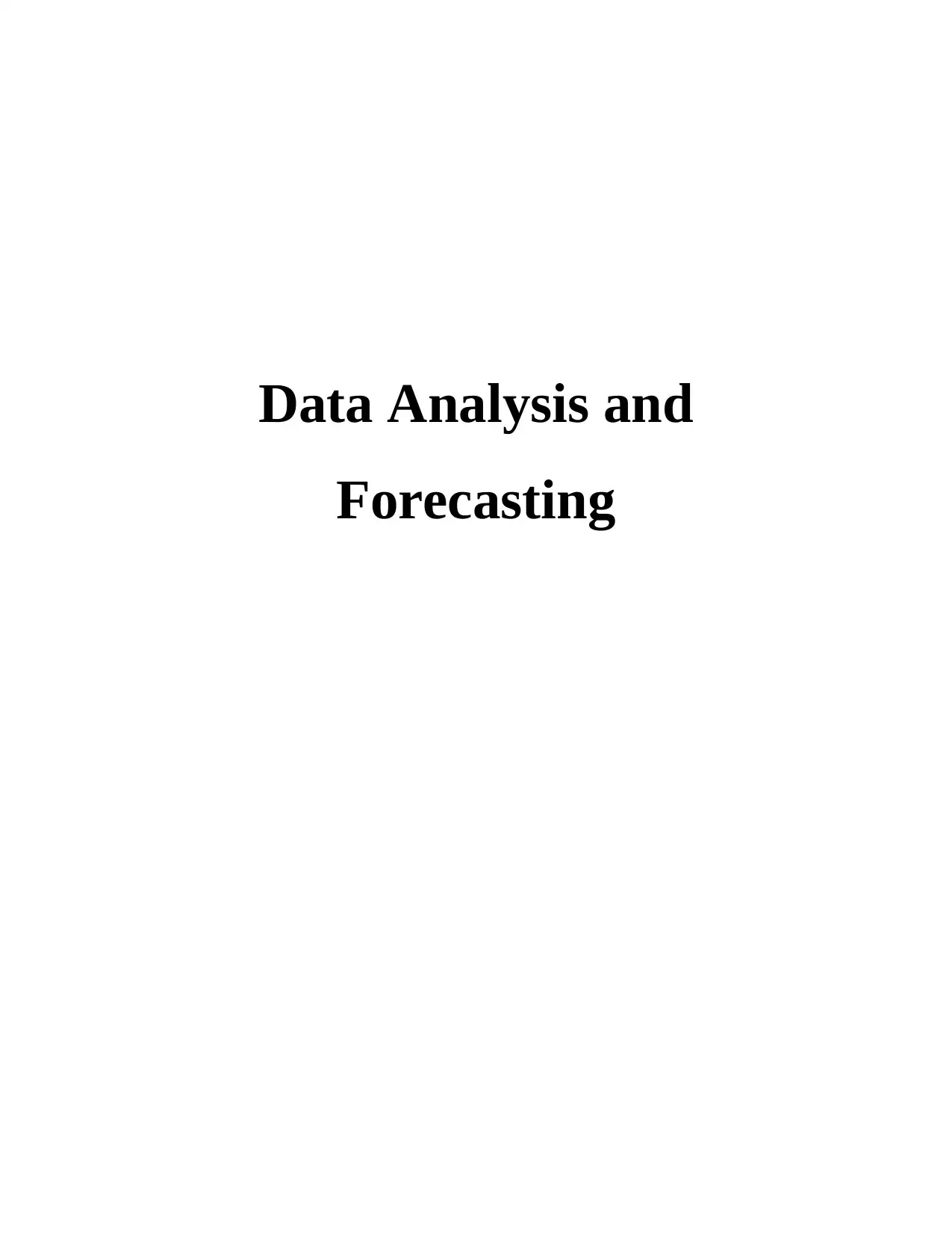
Data Analysis and
Forecasting
Forecasting
Paraphrase This Document
Need a fresh take? Get an instant paraphrase of this document with our AI Paraphraser
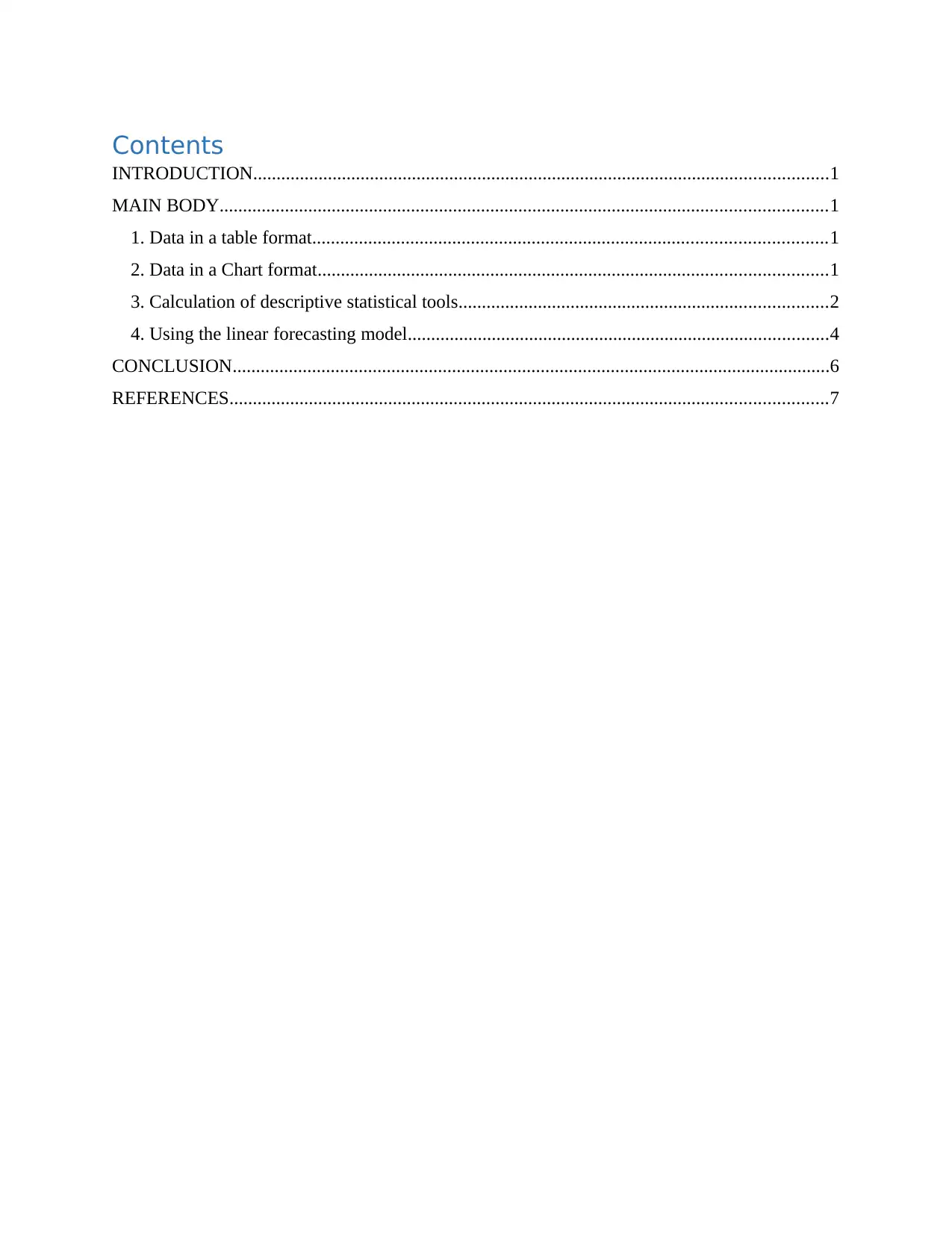
Contents
INTRODUCTION...........................................................................................................................1
MAIN BODY..................................................................................................................................1
1. Data in a table format..............................................................................................................1
2. Data in a Chart format.............................................................................................................1
3. Calculation of descriptive statistical tools...............................................................................2
4. Using the linear forecasting model..........................................................................................4
CONCLUSION................................................................................................................................6
REFERENCES................................................................................................................................7
INTRODUCTION...........................................................................................................................1
MAIN BODY..................................................................................................................................1
1. Data in a table format..............................................................................................................1
2. Data in a Chart format.............................................................................................................1
3. Calculation of descriptive statistical tools...............................................................................2
4. Using the linear forecasting model..........................................................................................4
CONCLUSION................................................................................................................................6
REFERENCES................................................................................................................................7
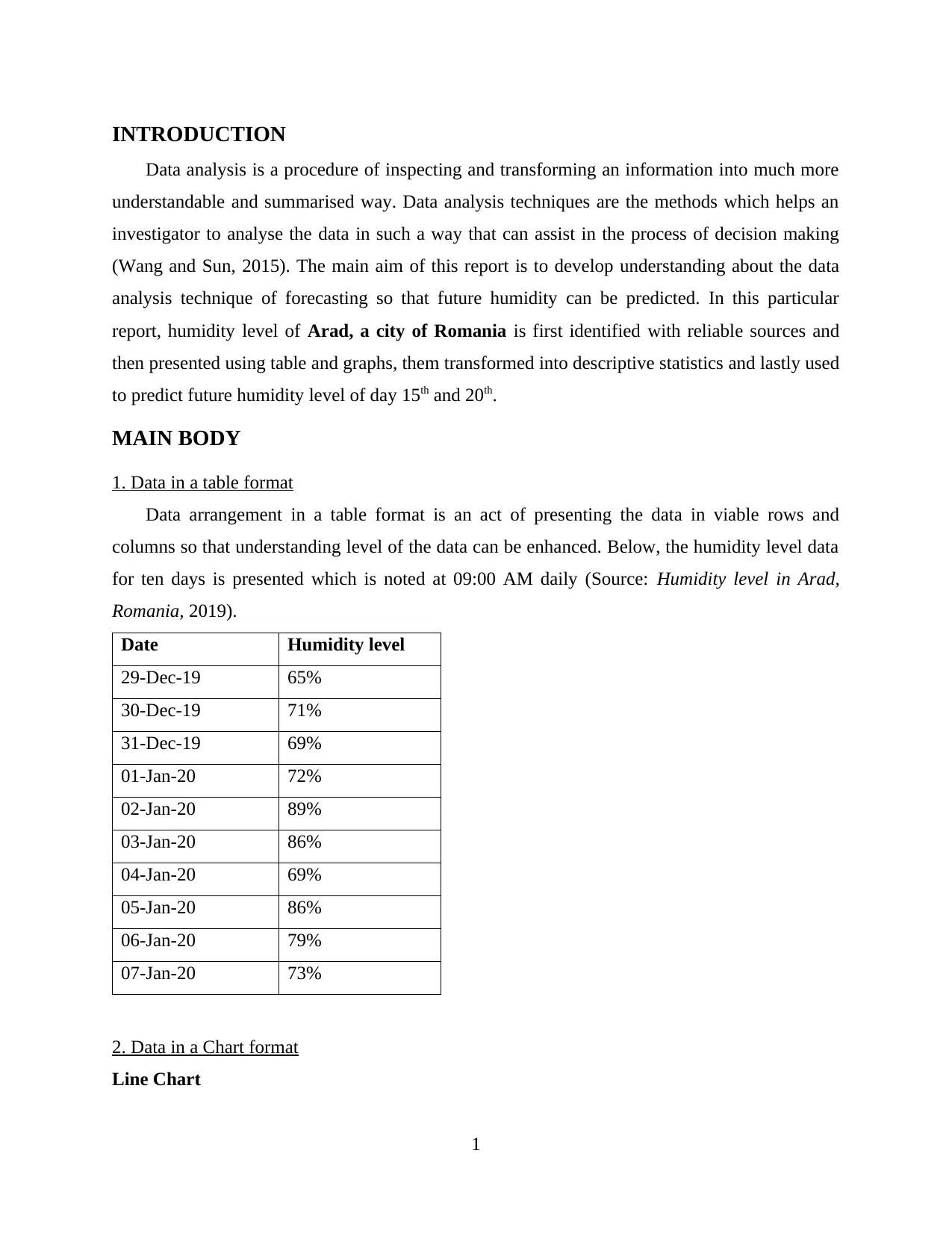
INTRODUCTION
Data analysis is a procedure of inspecting and transforming an information into much more
understandable and summarised way. Data analysis techniques are the methods which helps an
investigator to analyse the data in such a way that can assist in the process of decision making
(Wang and Sun, 2015). The main aim of this report is to develop understanding about the data
analysis technique of forecasting so that future humidity can be predicted. In this particular
report, humidity level of Arad, a city of Romania is first identified with reliable sources and
then presented using table and graphs, them transformed into descriptive statistics and lastly used
to predict future humidity level of day 15th and 20th.
MAIN BODY
1. Data in a table format
Data arrangement in a table format is an act of presenting the data in viable rows and
columns so that understanding level of the data can be enhanced. Below, the humidity level data
for ten days is presented which is noted at 09:00 AM daily (Source: Humidity level in Arad,
Romania, 2019).
Date Humidity level
29-Dec-19 65%
30-Dec-19 71%
31-Dec-19 69%
01-Jan-20 72%
02-Jan-20 89%
03-Jan-20 86%
04-Jan-20 69%
05-Jan-20 86%
06-Jan-20 79%
07-Jan-20 73%
2. Data in a Chart format
Line Chart
1
Data analysis is a procedure of inspecting and transforming an information into much more
understandable and summarised way. Data analysis techniques are the methods which helps an
investigator to analyse the data in such a way that can assist in the process of decision making
(Wang and Sun, 2015). The main aim of this report is to develop understanding about the data
analysis technique of forecasting so that future humidity can be predicted. In this particular
report, humidity level of Arad, a city of Romania is first identified with reliable sources and
then presented using table and graphs, them transformed into descriptive statistics and lastly used
to predict future humidity level of day 15th and 20th.
MAIN BODY
1. Data in a table format
Data arrangement in a table format is an act of presenting the data in viable rows and
columns so that understanding level of the data can be enhanced. Below, the humidity level data
for ten days is presented which is noted at 09:00 AM daily (Source: Humidity level in Arad,
Romania, 2019).
Date Humidity level
29-Dec-19 65%
30-Dec-19 71%
31-Dec-19 69%
01-Jan-20 72%
02-Jan-20 89%
03-Jan-20 86%
04-Jan-20 69%
05-Jan-20 86%
06-Jan-20 79%
07-Jan-20 73%
2. Data in a Chart format
Line Chart
1
⊘ This is a preview!⊘
Do you want full access?
Subscribe today to unlock all pages.

Trusted by 1+ million students worldwide

Pie chart
3. Calculation of descriptive statistical tools
Mean
This is the statistical average of the values in a data set which is computed by comparing
sum of the values with total number of the values. Mean for the data set of ten days’ humidity
level is calculated below:
Formula: Mean = Σx / n
= 759% / 10
= 75.9 or 76%
2
3. Calculation of descriptive statistical tools
Mean
This is the statistical average of the values in a data set which is computed by comparing
sum of the values with total number of the values. Mean for the data set of ten days’ humidity
level is calculated below:
Formula: Mean = Σx / n
= 759% / 10
= 75.9 or 76%
2
Paraphrase This Document
Need a fresh take? Get an instant paraphrase of this document with our AI Paraphraser
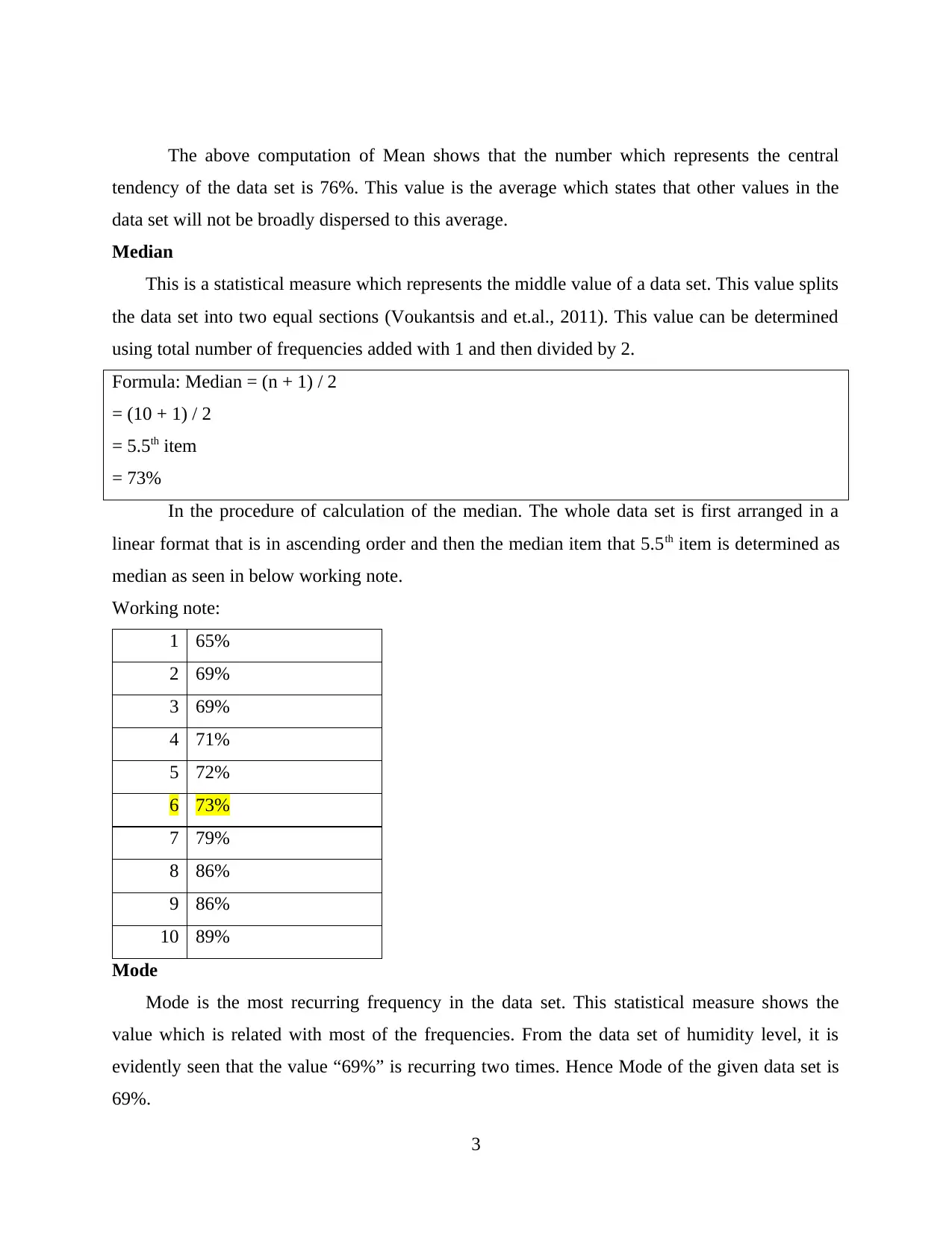
The above computation of Mean shows that the number which represents the central
tendency of the data set is 76%. This value is the average which states that other values in the
data set will not be broadly dispersed to this average.
Median
This is a statistical measure which represents the middle value of a data set. This value splits
the data set into two equal sections (Voukantsis and et.al., 2011). This value can be determined
using total number of frequencies added with 1 and then divided by 2.
Formula: Median = (n + 1) / 2
= (10 + 1) / 2
= 5.5th item
= 73%
In the procedure of calculation of the median. The whole data set is first arranged in a
linear format that is in ascending order and then the median item that 5.5th item is determined as
median as seen in below working note.
Working note:
1 65%
2 69%
3 69%
4 71%
5 72%
6 73%
7 79%
8 86%
9 86%
10 89%
Mode
Mode is the most recurring frequency in the data set. This statistical measure shows the
value which is related with most of the frequencies. From the data set of humidity level, it is
evidently seen that the value “69%” is recurring two times. Hence Mode of the given data set is
69%.
3
tendency of the data set is 76%. This value is the average which states that other values in the
data set will not be broadly dispersed to this average.
Median
This is a statistical measure which represents the middle value of a data set. This value splits
the data set into two equal sections (Voukantsis and et.al., 2011). This value can be determined
using total number of frequencies added with 1 and then divided by 2.
Formula: Median = (n + 1) / 2
= (10 + 1) / 2
= 5.5th item
= 73%
In the procedure of calculation of the median. The whole data set is first arranged in a
linear format that is in ascending order and then the median item that 5.5th item is determined as
median as seen in below working note.
Working note:
1 65%
2 69%
3 69%
4 71%
5 72%
6 73%
7 79%
8 86%
9 86%
10 89%
Mode
Mode is the most recurring frequency in the data set. This statistical measure shows the
value which is related with most of the frequencies. From the data set of humidity level, it is
evidently seen that the value “69%” is recurring two times. Hence Mode of the given data set is
69%.
3

Range
In the terms of numeracy and data analysis, range is the measure which represents the data
set that is the difference between largest and smallest values. Range is often used to analyse the
statistical dispersion.
Formula: Range = Maximum band value – Minimum band value
= 89% - 65%
= 24%
From the above calculation, it has been seen that the minimum frequency value in the
humidity data set is 65% and maximum is 89%. The difference between these two values is 24%
which is considered as the range for this data set.
Standard deviation
This is a statistical measure which shows the amount of variability in a data set and the
range from which the values in that data set is dispersed from the average mean. Higher the
dispersion between frequency values is, higher the standard deviation will be (Patterson and
et.al., 2011).
Formula: Standard Deviations = √ (variance)
Variance 2 = {∑ (x – mean) / N}2
= {∑ (x2 / N – (mean)2}
= {583% / 10 – (76%) 2}
= {58.3% – 58%}
= 0.3
Std. Dev. = √ 0.3
Standard deviation = 0.547
From the above calculation, it has been observed that the level of dispersion or chances of
standard errors are less as the standard deviation for the humidity data level is less than 0 that is
0.547.
4. Using the linear forecasting model
(i). Calculation of m value
Date Day
(X)
Humidity data (%)
(Y) X * Y X ^ 2
29-Dec-19 1 65% 65% 1
4
In the terms of numeracy and data analysis, range is the measure which represents the data
set that is the difference between largest and smallest values. Range is often used to analyse the
statistical dispersion.
Formula: Range = Maximum band value – Minimum band value
= 89% - 65%
= 24%
From the above calculation, it has been seen that the minimum frequency value in the
humidity data set is 65% and maximum is 89%. The difference between these two values is 24%
which is considered as the range for this data set.
Standard deviation
This is a statistical measure which shows the amount of variability in a data set and the
range from which the values in that data set is dispersed from the average mean. Higher the
dispersion between frequency values is, higher the standard deviation will be (Patterson and
et.al., 2011).
Formula: Standard Deviations = √ (variance)
Variance 2 = {∑ (x – mean) / N}2
= {∑ (x2 / N – (mean)2}
= {583% / 10 – (76%) 2}
= {58.3% – 58%}
= 0.3
Std. Dev. = √ 0.3
Standard deviation = 0.547
From the above calculation, it has been observed that the level of dispersion or chances of
standard errors are less as the standard deviation for the humidity data level is less than 0 that is
0.547.
4. Using the linear forecasting model
(i). Calculation of m value
Date Day
(X)
Humidity data (%)
(Y) X * Y X ^ 2
29-Dec-19 1 65% 65% 1
4
⊘ This is a preview!⊘
Do you want full access?
Subscribe today to unlock all pages.

Trusted by 1+ million students worldwide

30-Dec-19 2 71% 142% 4
31-Dec-19 3 69% 207% 9
01-Jan-20 4 72% 288% 16
02-Jan-20 5 89% 445% 25
03-Jan-20 6 86% 516% 36
04-Jan-20 7 69% 483% 49
05-Jan-20 8 86% 688% 64
06-Jan-20 9 79% 711% 81
07-Jan-20 10 73% 730% 100
Total 55 759% 4275% 385
Particulars Details
m NΣxy – Σx Σy / N Σ x ^ 2 – (Σx) ^ 2
(10 * 4275) - (55 * 759) / ( 10 * 385)
- (55) ^ 2
(42750 - 41745) / (3850 - 3025)
1.21
(ii). Calculation of c value
Particulars Details
c Σy - m Σx / N
(759 - (1.21 * 55)) / 10
69.24
(iii). Forecasting humidity level for 15th day and 20th day
Forecast of 15th day
y = mx + c
y 1.21 (x) + 69.24
x 15
5
31-Dec-19 3 69% 207% 9
01-Jan-20 4 72% 288% 16
02-Jan-20 5 89% 445% 25
03-Jan-20 6 86% 516% 36
04-Jan-20 7 69% 483% 49
05-Jan-20 8 86% 688% 64
06-Jan-20 9 79% 711% 81
07-Jan-20 10 73% 730% 100
Total 55 759% 4275% 385
Particulars Details
m NΣxy – Σx Σy / N Σ x ^ 2 – (Σx) ^ 2
(10 * 4275) - (55 * 759) / ( 10 * 385)
- (55) ^ 2
(42750 - 41745) / (3850 - 3025)
1.21
(ii). Calculation of c value
Particulars Details
c Σy - m Σx / N
(759 - (1.21 * 55)) / 10
69.24
(iii). Forecasting humidity level for 15th day and 20th day
Forecast of 15th day
y = mx + c
y 1.21 (x) + 69.24
x 15
5
Paraphrase This Document
Need a fresh take? Get an instant paraphrase of this document with our AI Paraphraser

y 1.21 (15) + 69.24
87.39
Forecast of 20th day
y = mx + c
y 1.21 (x) + 69.24
x 20
y 1.21 (20) + 69.24
93.44
Linear equation mode of mx+c is used above in order to predict the future humidity level
of Arad, Romania. The value of “m” represents the humidity level whereas the value “c”
represents the days of which humidity level is pre determined (Montgomery, Jennings and
Kulahci, 2015). These values are then used to predicted two Xs that are humidity level of day
15th and 20th. From the above analysis, it can be seen that humidity level for day 15th will be
87.39% and 93.44% for day 20th.
CONCLUSION
From the above report, it has been concluded that the procedure of data analysis is a
complex process which includes various sub tasks of identifying, classifying, transforming and
even predicting the data.
6
87.39
Forecast of 20th day
y = mx + c
y 1.21 (x) + 69.24
x 20
y 1.21 (20) + 69.24
93.44
Linear equation mode of mx+c is used above in order to predict the future humidity level
of Arad, Romania. The value of “m” represents the humidity level whereas the value “c”
represents the days of which humidity level is pre determined (Montgomery, Jennings and
Kulahci, 2015). These values are then used to predicted two Xs that are humidity level of day
15th and 20th. From the above analysis, it can be seen that humidity level for day 15th will be
87.39% and 93.44% for day 20th.
CONCLUSION
From the above report, it has been concluded that the procedure of data analysis is a
complex process which includes various sub tasks of identifying, classifying, transforming and
even predicting the data.
6
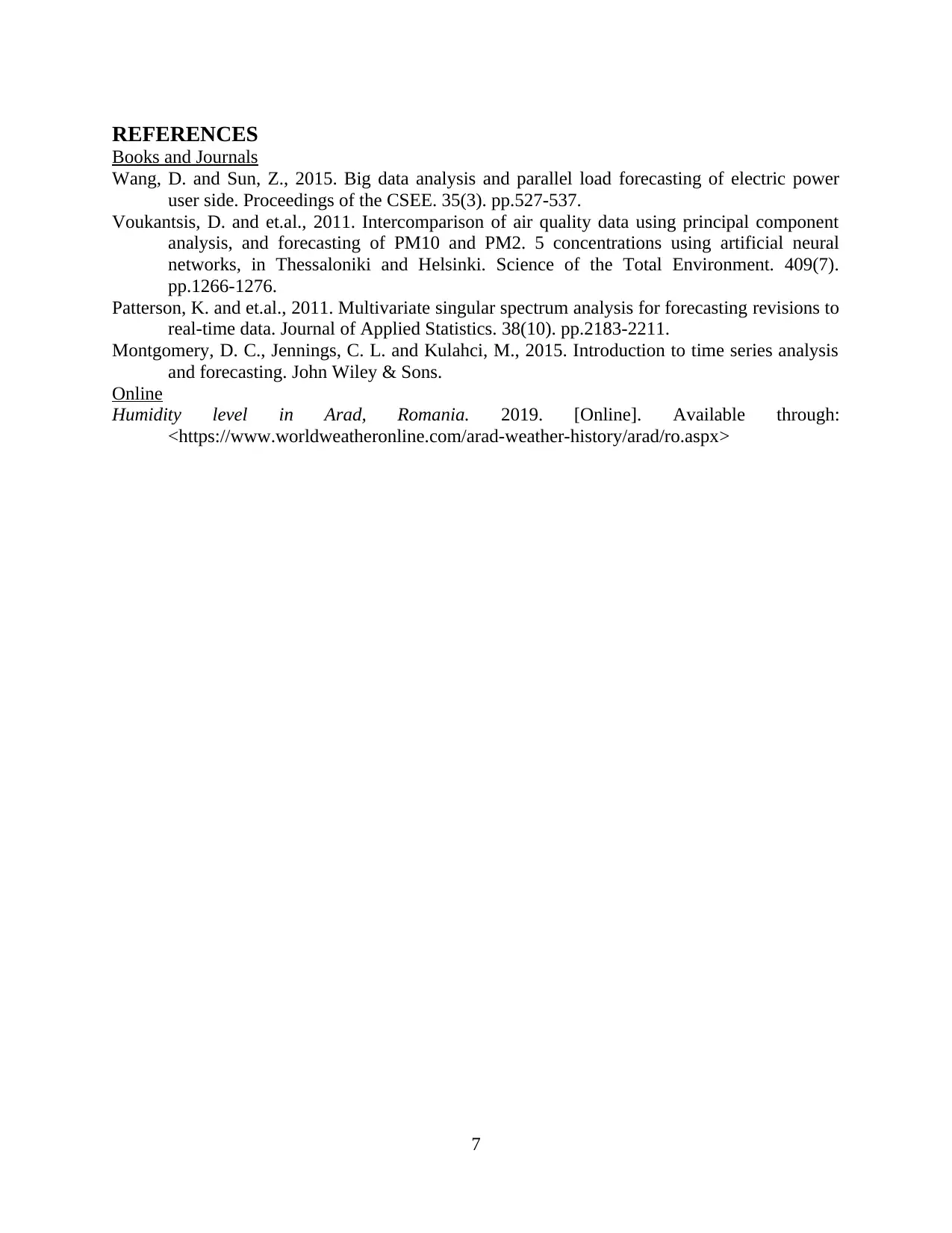
REFERENCES
Books and Journals
Wang, D. and Sun, Z., 2015. Big data analysis and parallel load forecasting of electric power
user side. Proceedings of the CSEE. 35(3). pp.527-537.
Voukantsis, D. and et.al., 2011. Intercomparison of air quality data using principal component
analysis, and forecasting of PM10 and PM2. 5 concentrations using artificial neural
networks, in Thessaloniki and Helsinki. Science of the Total Environment. 409(7).
pp.1266-1276.
Patterson, K. and et.al., 2011. Multivariate singular spectrum analysis for forecasting revisions to
real-time data. Journal of Applied Statistics. 38(10). pp.2183-2211.
Montgomery, D. C., Jennings, C. L. and Kulahci, M., 2015. Introduction to time series analysis
and forecasting. John Wiley & Sons.
Online
Humidity level in Arad, Romania. 2019. [Online]. Available through:
<https://www.worldweatheronline.com/arad-weather-history/arad/ro.aspx>
7
Books and Journals
Wang, D. and Sun, Z., 2015. Big data analysis and parallel load forecasting of electric power
user side. Proceedings of the CSEE. 35(3). pp.527-537.
Voukantsis, D. and et.al., 2011. Intercomparison of air quality data using principal component
analysis, and forecasting of PM10 and PM2. 5 concentrations using artificial neural
networks, in Thessaloniki and Helsinki. Science of the Total Environment. 409(7).
pp.1266-1276.
Patterson, K. and et.al., 2011. Multivariate singular spectrum analysis for forecasting revisions to
real-time data. Journal of Applied Statistics. 38(10). pp.2183-2211.
Montgomery, D. C., Jennings, C. L. and Kulahci, M., 2015. Introduction to time series analysis
and forecasting. John Wiley & Sons.
Online
Humidity level in Arad, Romania. 2019. [Online]. Available through:
<https://www.worldweatheronline.com/arad-weather-history/arad/ro.aspx>
7
⊘ This is a preview!⊘
Do you want full access?
Subscribe today to unlock all pages.

Trusted by 1+ million students worldwide
1 out of 9
Related Documents
Your All-in-One AI-Powered Toolkit for Academic Success.
+13062052269
info@desklib.com
Available 24*7 on WhatsApp / Email
![[object Object]](/_next/static/media/star-bottom.7253800d.svg)
Unlock your academic potential
Copyright © 2020–2025 A2Z Services. All Rights Reserved. Developed and managed by ZUCOL.



